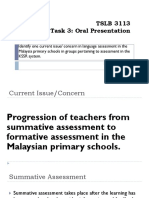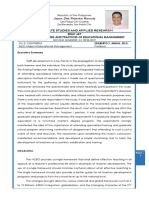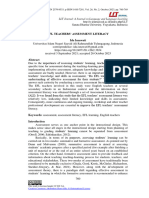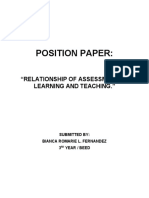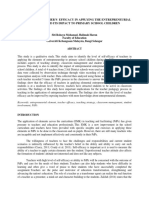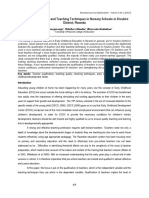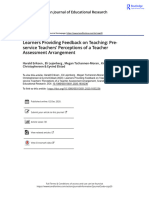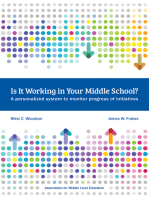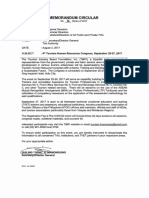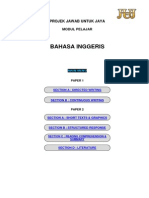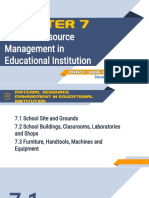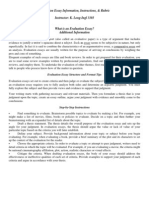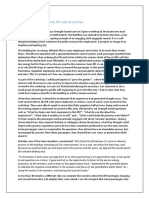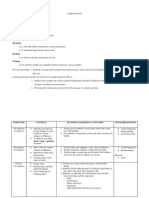Rubric
Uploaded by
api-304124523Rubric
Uploaded by
api-304124523US-China Education Review B, April 2015, Vol. 5, No.
4, 245-256
doi: 10.17265/2161-6248/2015.04.003
DAVID
PUBLISHING
Development of the Double Layer Rubric for the Study on
the Implementation of School-based Assessment
Among Teachers
Mohd Sahandri Gani Bin Hamzah, Noorzeliana Idris
Sultan Idris Education University, Tanjong Malim, Malaysia
Saifuddin Kumar Abdullah
Ministry of Education, Putrajaya, Malaysia
Norazilawati Abdullah, Mazura Mastura Muhammad
Sultan Idris Education University, Tanjong Malim, Malaysia
The school-based assessment (SBA) is a holistic assessment which evaluates the cognitive, affective, and
psychomotor aspects in line with the goals of the Malaysian National Philosophy of Education (NPE) in the
national curriculum. The extent of achieving the goals of the NPE and national education depends on the teachers
as its implementers. Therefore, this study aims to identify the extent of the implementation of SBA within teachers
from the aspect of knowledge and skills, teachers planning, the implementation of assessment, item construction,
as well as teachers restraints in implementing SBA. Through the literature analyses related to the implementation
of SBA, it was found that many teachers did not know and were not skilled in assessing their students. This could
affect the reliability and the validity of the assessment. In the many studies that were observed, a majority of
teachers still refuse to accept the implementation of SBA. A detailed response is needed to gain the correct
information from the teachers. The use of rubrics in the instruments enables gaining more detailed information and
reports which are more profound could be presented. This study discusses the steps in constructing instruments in
the form of the double layer rubric to identify the extent of SBA implementation within teachers. The Instrument
Determination Table was developed to accommodate related elements until it produces items which are able to
measure a construct or sub-construct. After the validation process from five professionals, a pilot study was
conducted. The discussion focuses on the issues and the procedures on the methods in which the validity and
reliability of the instruments were built on through five professionals and the internal uniformity via the Cronbachs
alpha. Therefore, the item analysis to determine the status of statements can be explained by the scores of each
rubric objectively and systematically. Undeniably, the uniqueness of an instrument does not only depend on the
Mohd Sahandri Gani Bin Hamzah, B.S., M.Ed., PhD., professor, Faculty of Education and Human Development, Sultan Idris
Education University.
Noorzeliana Idris, B.Ed., M.A., Ph.D. candidate, Faculty of Education and Human Development, Sultan Idris Education
University.
Saifuddin Kumar Abdullah, B.Ed., M.Ed., Ph.D. candidate, Department of Polytechnic, Ministry of Education.
Norazilawati Abdullah, B.Ed., M.Ed., Ph.D., lecturer, Faculty of Education and Human Development, Sultan Idris Education
University.
Mazura Mastura Muhammad, B.Ed., M.A., Ph.D., lecturer, Faculty of Languages and Communication, Sultan Idris Education
University.
THE IMPLEMENTATION OF SCHOOL-BASED ASSESSMENT AMONG TEACHERS
246
issues of validity and reliability, but also on the creativity of researchers as well as the method in which these
evidences can be integrated in the context of research design. What is certain here is that the uniqueness of an
instrument will be further highlighted if the study is able to produce findings that can bring impact towards the
progress of education. It is hoped that this rubric can be used more effectively in measuring what is needed to be
measured in the SBA implementation study within teachers.
Keywords: school-based assessment (SBA), double layer rubric, Instrument Determination Table
Introduction
According to the aims of the Malaysian National Philosophy of Education (NPE), the intended outcome of
the philosophy is an individual who is complete and equipped, not the one who just passes examimations.
Generally, it can be observed that Malaysian educational system encourages students to learn and memorise for
the sake of examination. Knowledge received in this way will not last and students may forget what they have
learnt right after the examinations. This means that success in examinations cannot provide a real illustration on
the success of mastering a curriculum (Omar, 2001; Azman, 1987).
The Malaysian Ministry of Education (MoE) is very concerned towards the claims that the national
education system has become too exam-oriented (MoE, 2012). Therefore, a cabinet meeting dated 17th
December, 2010, has agreed to the implementation of SBA as a part of the education transformation
programme. It concurs with the vision and aspiration stated in the early report of the Malaysian Educational
Development Plan 2013-2025, where the MoE had stressed on the concept of quality that is compulsory within
each student. The school-based assessment (SBA) is an assessment that is holistic and is able to assess the
cognitive (intellectual), affective (emotional and spiritual), and psychomotor (physical) aspects in accordance
with the NPE, the Primary School Standard Curriculum, and the Secondary School Standard Curriculum.
Nevertheless, the effectiveness of a reform in education relies on the factor of teachers who carry out the
assessment. Change will not exist if the teachers do not understand the need to change and ready to change the
paradigm. It is hoped that this form of assessment will produce human capital that are critical, creative,
innovative, competitive, and progressive as hoped by the nation (Malaysian Examinations Syndicate, 2012).
Based on this study, the construction of the research instruments is done using the double layer
rubric scale. This approach is able to provide a more detailed input which does not only cover the score
scale status, but also explains the levels according to the rubric scores. The strengths of using this instrument
for each item or statement do not lie only on the focus of the score mean status, but on the ability to further
determine the level of weak, medium, or strong with clearer descriptive explanation. The findings would also
be simpler to read on the report, facilitate solution finding, and note recommendations more quickly and
meaningfully.
Problem Statement
The observation and talk of teachers in schools lead to a realisation that teachers are feeling very worried
about the burden of tasks, like the burden of planning and designing as well as implementing assessment on
their students. This statement has been discussed in the findings of Tunstalls (2001) study on teachers worries
related to SBA in assessment. This situation explains that assessing students can be difficult, especially for new
teachers who have just started their service in a school.
THE IMPLEMENTATION OF SCHOOL-BASED ASSESSMENT AMONG TEACHERS
247
It is generally known that SBA is a new epoch in the assessment system by the MoE of Malaysia that will
abolish central examinations, such as the Primary School Achievement Test (UPSR) and Lower Secondary
Assessment (PMR). Hence, teachers are given full responsibility in assessing their students according to the
standard assessment procedure on the students. Even though teachers have undergone courses organised by the
MoE, they still lack the confidence in assessing students. This situation is further exacerbated when teachers
have inadequate knowledge, skills, and materials to assist them in the assessment. This situation was brought
forth by Radin (2008), who said that teachers wish for a more professional training in assessment to gain the
knowledge and skills, so that SBA can be implemented more successfully. Teachers want to be equipped with
resources, such as the Performance Standards document, assessment manual, instrument examples, marking
schemes, and many more. Training and workshops are very important to increase the skills and confidence of
teachers to design the form and the implementation of SBA.
Overall, SBA plays a role in testing and evaluating the performance of students in all aspects, but there is
also limitation in terms of accuracy because the total number of students in classroom is still exceed than 40.
The assessment covers academic, co-curricular, and character performance throughout students experiences in
the teaching and learning process. Teachers who are given responsibility and play roles in carrying out SBA in
rigorous and systematic process need to follow all the necessary steps and procedures of assessment. However,
the lack of seriousness of the teachers in assessing will disrupt the whole assessment system. The quality of
assessment can be questioned by all if there is no monitoring system. If this happens, it could lead to unfairness,
non-transparency, and disuniformity in assessing students, even though fairness, transparency, and uniformity
are important elements in determining correct grades are given to students throughout their learning process.
This situation was discussed by Tan (2010), who highlights on the lack of monitoring system which will lead to
frivolousness of the teachers in assessing their students. Therefore, teachers need to be monitored using a valid
and suitable assessment standard.
The exam system has given emotional pressure to parents, teachers, and even the students themselves.
However, the exam system has actually restrained students creativity to present and show their performance as
well as their real abilities in learning. Teachers have also become less creative in their learning patterns when
they teach for exams. All this time, teachers are the ones who work hard in carrying out the teaching and
learning process, but external examiners are the ones who assess their students. SBA will return the right of
assessment to the teachers and teachers would have to change their teaching patterns by using many teaching
strategies, so that students would fully master learning. However, from the observation, teachers consider that
the varying teaching strategies would only waste time because assessments need to be done after teaching.
While teaching, teacher can access, and at the same time, they have to guide and report their performance
instantaneously. This view was denied by Tseko (2005), who mentioned that SBA is very important for
students, because assessment is conducted in the teaching and learning process, hence, allowing the students to
know their ability and performance. In other words, while teaching, teachers can access, and at the same time,
guide and report on their students performance instantaneously.
Nonetheless, after almost four years of implementing SBA in schools, teachers have started to complain
about the amount of burden that has to be shouldered and this has reached even the news. Many teachers agree
on the abolishment of SBA. This is further supported by an online study by the MoE to see the agreement of
teachers in implementing SBA, where almost 75% of the teachers agree on its discontinuation. This was further
proven by the support (more than 70,000 teachers) given on Facebook page created especially for the
THE IMPLEMENTATION OF SCHOOL-BASED ASSESSMENT AMONG TEACHERS
248
abolishment of SBA (https://www.facebook.com/KamiMahuSPPBSDimansuhkan). Furthermore, the MoE has
stopped the implementation temporarily in February, 2013, to re-study all the complaints being made on the
implementation of SBA, which was said to be in haste. The burdens of teachers were also discussed in a study
by Tan (2010). Among the burdens discussed are clerical work, marks input process, and the filing system that
limits teachers creativity in implementing SBA. Because SBA has been implemented in Malaysia since 2010,
a comprehensive study needs to be conducted to evaluate the procedures, planning and executing processes, as
well as the teachers restraints in the implemention.
The Implementation of SBA
Current assessments are based on the curriculum that only covers the ability of students in remembering
and memorising. Other skills are not applied, analysed, synthesised, and evaluated in an evaluation (Begum &
Farooqui, 2008). SBA was initially used as a new method in the educational system because of the increasing
awareness on the tests that are only based on the curriculum and teaching (Dikli, 2003).
The type of assessment also provides focus towards the development and performance of teachers where if
a student fails to complete the task given at certain times, the student still has the chance to show his/her skills
on other different times and situations. Since SBA was developed in the contexts from one time to another,
teachers have the chance to measure the strengths and weaknesses of stuents in many fields and situations (Law
& Eckes, 1995). Hence, teachers need to have adequate knowledge and skills before conducting assessment.
Consistent with Shapard (2000), teachers who make changes need to be given the knowledge and skills:
Progressive educational required infinitely skilled teacher being able to ask the right questions at the right time,
anticipate conceptual pitfalls, and have at the read repertoire of task that will help student take the next step requires deep
knowledge of subject matter. Teachers will also need knowledge in learning to use assessment in a new way. (Shapard,
2000, p. 71)
Arranged planning before assessment is needed for teachers to ensure the fluidity of the assessment
process. James and Charles (1995) stated in their book, Management, that planning is defined as a guideline
designed to achieve the initial meaning of the founding. Meanwhile, planning helps the management of the
organisation to determine the direction of the organisation, and decide on issues related to the questions on
what, when, and how a plan is going to be executed and who will carry out the execution.
Namara (1998) added and explained that effective programme planning needs to be prepared consistent
with the missions and goals of the organisation through teamwork and structure while determining the keys to
success, recheck, and evaluate the planning for the programme. The opinion of Namara (1998) is consistent
with the opinion of the the Malaysian Examinations Syndicate (2013), who stated that detail planning needs to
be executed in groups between the Malaysian Examination Syndicate, state educational departments, and
appointed SBA executors. Therefore, in schools, all teachers planning needs to be robust before teaching, so
that assessments can be applied successfully.
Stoner and Wankel (1995) have given the view that planning without executing is a wasted act. After
planning, execution is needed. Seeing that assessment and instrument construction is a compulsory matter for
all teachers in executing SBA (Malaysian Examination Syndicate, 2012), teachers will need to plan first, so that
their execution is more orderly and systematic. However, it is believed that there are many restraints for
teachers throughout the implementation of SBA.
THE IMPLEMENTATION OF SCHOOL-BASED ASSESSMENT AMONG TEACHERS
249
In the context of this study, SBA teachers will provide response on their knowledge and skills, planning
and execution of assessment, and instrument construction, as well as the restraints faced by them throughout the
implementation of SBA.
The Development of Constructing a Double Layer Rubric Instrument
The analysis instrument for the implementation of SBA within teachers is based on previous literature and
studies. There are 28 items and 133 rubrics which are then categorised into five constructs consisting of:
(a) Teachers knowledge and skills;
(b) Teachers planning in executing the SBA;
(c) Execution of the SBA;
(d) SBA instrument construction;
(e) Teachers restraints in executing SBA.
In this study, the construction of the double layer instrument went through six levels. Firlty, the constructs
of SBA implementation by teachers are checked through literature analysis and documents from the MoE.
Secondly, to identify the accuracy of the constructs of SBA implementation within teachers, a structured interview
was planned. Two officers from the District Education Office and a school main trainer were interviewed to
update the items and rubrics constructed. The third step involved checks by five professionals in the field of
curriculum on the items and rubrics to as well as suggestions for improvement. The fourth step involved
rechecking of the items based on the comments and inputs gained from the group of professionals. The fifth
step involved the construction of the Instrument Determination Table consisting of planning and complete set
determination by considering the rubric scales and scores. Constructs and sub-constructs which were determined
were supported by literature whereas trait and item designs based on the subjects and predicates were controlled
by syllabus and the principles of measuring and assessment (see Table 1). The final step in item construction
involved item testing through pilot study to observe the readability, clarity, and accuracy of the items. By doing
these, the instructions and statements for any items that are not clear can be identified and then changed.
The final version of the instrument was successfully produced containing 28 items with 133 rubrics, and
each item contains five rubrics that represent certain evaluation scales, as shown in Table 2.
Table 1
Test Determination Table
Construct
Sub-construct
Scale
Item:
I acquire knowledge and skills about SBA during____.
B1a. Teachers
knowledge and skills
resources
Rubric:
B1a1. Course registration at education department or
district education department;
B1a2. Internal course;
B1a3. In-service training;
B1a4. Surfing exam board Website;
B1a5. Discuss with collegues.
Likert scale:
1
0No;
1Yes.
THE IMPLEMENTATION OF SCHOOL-BASED ASSESSMENT AMONG TEACHERS
250
(Table 1 to be continued)
Item:
I know how to do the following activities:
B1b. Teachers
knowledge in
implementing SBA
Rubric:
B1b1. Develop instruments;
B1b2. Use instruments for assessing students;
B1b3. Assess the evidence of students;
B1b4. Explainthe assessment criteria to the students;
B1b5. Adjust the instrument with the teaching method.
0Do not know;
1Know some;
2Fully know.
Likert scale:
1
2
3
4
5
Item:
I am skilled to do the following:
B1. Knowledge and
skills
Rubric:
B1c1. Develop instruments;
B1c2. Use instruments for assessing students;
B1c3. Assess the evidence of students;
B1c. Teachers skills in B1c4. Explain the assessment criteria to the
implementing SBA
students;
B1c5. Adjust the instrument with the teaching
method.
0Unskilled;
1Skilled
at
certain part;
2Fully skilled.
Likert scale:
1
2
3
4
5
Item:
I understand the term of following assessment:
B1d. Teachers
knowledge about the
terms in SBA
Rubric:
B1d1. Document Standard Performance;
B1d2. Document Standard Curriculum;
B1d3. Descriptor;
B1d4. Bands;
B1d5. Malaysian Educational Development Plan.
0Do not
understand;
1Understand
certain part;
2Fully
understand.
Likert scale:
1
2
3
4
5
B2a. Teachers planning status;
B2. Teachers
B2b. Planning before SBA assessment;
planning
B2c. Instrument construction planning;
B2d. Planning before teaching.
B3a. Teachers status in implementing SBA;
B3b. Things done throughout the assessment activities;
B3c. Teachers practice in assessment;
B3d. Things done by teachers for students who have not master the learning;
B3e. Things done during assessment;
B3. Implementaion of
B3f. Things done in the process of assessment;
the SBA assessment
B3g. Method teachers use to manage students evidence;
B3h. Ways teachers conduct scoring;
B3i. Criteria during students assessment;
B3j. Teachers assessment criteria;
B3k. Teachers reporting criteria.
0No;
1Sometimes;
2Yes.
0No;
1Sometimes;
2Yes.
THE IMPLEMENTATION OF SCHOOL-BASED ASSESSMENT AMONG TEACHERS
(Table 1 to be continued)
B4a. Teachers status in instrument construction;
B4b. Ways teachers prepare instruments;
B4. Instrument
B4c. Ways teachers construct instruments;
construction
B4d. Instruments used by teachers;
B4e. Other instruments used by teachers.
B5a. Teachers problems in implementing SBA;
B5. Teachers
B5b. Types of problems faced by teachers;
restraints in
B5c. Teachers problems during implementing SBA;
implementing SBA
B5d. Teachers burden throughout implementing SBA.
251
0No;
1Sometimes;
2Yes.
0No;
1Sometimes;
2Yes.
Table 2
Rubric Score
Statements
Do not know
Partially know
Completely know
No
Yes
Total rubric (5)
Total rubric (10)
Likert scale
Not skilled
Partially skilled
Completely skilled
1
0-2
1
Disagree
Agree
Strongly agree
2
3-4
2
No
Sometimes
Yes
3
5-6
3
No
Some parts
Yes
4
7-8
4
No
Yes
Yes
5
9-10
5
Rubric score
0
1
2
0
1
-
The 5-point scale is counted by researchers resulting from respondents evaluation based on five rubrics.
Each rubric brings a score ranging from 0 to 2 (0 = No; 1 = Sometimes; and 2 = Yes). The total rubric
scores are 10 points. These scores will be transferred to the ordinal scale, as shown in Table 3.
Table 3
Respondents Evaluation Based on Five Rubrics
Rubric score
0-2
3-4
5-6
7-8
9-10
Ordinal scale
1
2
3
4
5
For the dichotomy scales, the total rubric scores are 5 points. These scores will be transferred to the
ordinal scales, as shown in Table 4.
Table 4
Measurement Scale
Rubric score
0-1
2
3
4
5
Ordinal scale
1
2
3
4
5
Instrument Validation
The instrument is validated for each item by five professionals who determine the suitability of the
evaluated construct. One of the principles used in ensuring validation of the instrument is by making certain
THE IMPLEMENTATION OF SCHOOL-BASED ASSESSMENT AMONG TEACHERS
252
that each item is agreed by the five professionals. The minimum percentage of agreement for each item
validated should not be less than 80%.
Pilot Study
A pilot study was conducted first to ensure that the reliability of instrument record an index of no less than
0.67 (Nunnally, 1982) for the newly constructed instruments. It is also to ensure the accuracy of the instrument.
The pilot study was carried out on 57 people consisting of primary and secondary school teachers. The pilot
study instrument was conducted via the interaction survey method. The teachers are grouped into two groups
and the researchers read and explain each item to ensure that all respondents have the same understanding of
the items. Nonetheless, the response for each item is not guided by the researchers.
Reliability
The validity of a test relies on the reliability of that test. Because of that, only the measuring tool that can
give consistent readings can help the tool to give a valid measurement. Reliability is related to the level of
consistency between two measurements for the same reason (Creswell, 2003). Reliability is also the level that
shows that the measurement is free from error and can then produce consistent results. Reliability refers to
internal stability and consistency of the instrument in measuring a concept (Creswell, 2003).
A popular and frequently used test in measuring the internal consistency of a concept is the Cronbachs
alpha method (Cronbach, 1949; Norusis, 2005). The alpha coefficient value near to 1.00 shows that the items in
the scale are measuring the same things and have high reliability. According to Mohd (2005), a minimum value
of 0.6 is needed as a reliability index for the instruments to be used. Any value lower than that indicates that the
items are unacceptable. Alpha values of 0.6-0.8 are deemed acceptable and values more than 0.8 are deemed
good and have high reliability.
In this study, data analysis is conducted using the Statistic Package of Social Science (SPSS) Version 19
programme. The results of the reliability of the items processed are shown in Table 5.
Table 5
Cronbachs Alpha Coefficient
Input apects
Knowledge and skills
Teachers planning
SBA construction execution
Total items
4
Item correlation and total scores
Cronbachs alpha value
0.776
0.887
0.526
0.863
11
0.762
0.886
Instrument construction execution
0.667
0.887
Teachers restraints in executing SBA
0.564
0.885
Results
Table 5 summarises the reliability coefficients obtained from all the constructs of SBA implementation
within teachers. Based on Table 5, it was found that the Cronbachs alpha value is in the range of 0.863-0.887;
it was also found that the number of items for each component does not give the same effects towards the
reliability index given, which is the dimension of SBA assessment implementation (N = 11), even though there
are more items compared to the dimensions regarding teachers restraints in implementing SBA (N = 4), but
produce almost similar alpha values. From the alpha value obtained, and through considering the segregation of
the respondents based on two stratas (primary and secondary schools) that exist, it can be concluded that the
THE IMPLEMENTATION OF SCHOOL-BASED ASSESSMENT AMONG TEACHERS
253
score variation obtained is high. In short, the reliability index values obtained were quite high because of the
variety of several responses of SBA implementation within teachers that functions on the involved strata in
featuring the respondents.
Item Analysis
Based on the SPSS analysis instruction in the descriptive part by following the steps and procedures that
started from the click on the analysis icon, and then select descriptive statistic and related items, the results are
shown in Table 6.
Based on Table 6, the numbers show the mean scores and standard deviations for the items of knowledge
and skills (M = 3.81; SD = 0.26), teachers planning (M = 4.15; SD = 0.53), SBA assessment execution (M =
3.16; SD = 0.67), instrument construction (M = 3.52; SD = 0.55), and teachers restraints in implementing SBA
(M = 3.72; SD = 0.75) from the 57 respondents processed. The interpretation towards the items shows that the
respondents have knowledge and skills as well as planning at a high level compared to implementation of SBA
assessment execution and instrument construction at an average level. The respondents also admitted that they
have high restraints in implementing SBA. This interpretation is referred towards the standard criteria shown in
Table 6.
Table 6
Mean Scores of Items and Classification Status
N
SD
Status
Knowledge and skill
57
3.81
0.26
High
Teachers planning
57
4.15
0.53
High
SBA assessment execution
57
3.16
0.67
Average
Instrument construction
57
3.52
0.55
Average
Teachers restraints
57
3.72
0.75
High
The researcher has produced an implementation to classify the mean value of high, moderate, and low. All
three categories are shown in Table 7.
Table 7
Three Cateogies of Mean Score Interpretation
Score
Interpretation
1.00-2.33
Low level
2.34-3.66
Moderate level
3.67-5.00
High level
Note. Source: Mohd Sahandri (2011).
Item Descriptive Analysis
An analysis on a few descriptive items according to the rubric used in summarising the mean scores as
well as strengths and weaknesses is shown in Table 8.
The statistics in the Table 8 show descriptive score for the implementation of SBA among teachers in two
constructs: (a) skills and knowledge of teachers; and (b) instrument construction.
For the construct skills and knowledge, the mean score (3.81) is at a high level. Item 1 of this construct is
knowledge resource and teachers skills, which shows that 91% of the teachers get their knowledge and skills
THE IMPLEMENTATION OF SCHOOL-BASED ASSESSMENT AMONG TEACHERS
254
from internal courses while 44% of them through the examination syndicate Website. However, for item 2,
teachers knowledge in implementing SBA, it shows that 93% of the teachers use the Performance Standards
document and only 16% of the teachers do not know how to assess the students.
In the construct of instrument construction, the mean score (3.52) is at a moderate level. For item 1 of this
construct, the ways of teachers in constructing the instruments show that 63% of the teachers know a part of
constructing an instrument and only 14% of them do not know how to construct their instruments. In item 2,
instruments used by teachers, 89% of the teachers use pencil and paper as assessment instruments and only 3%
of them use projects as assessment instruments.
Table 8
Item Descriptives
Construct/variable
Mean score Item
Skills and knowledge
3.81
High
Instrument construction
3.52
Moderate
Elaboration
91% of the teachers get their knowledge and skills from internal
Knowledge resourse and courses
teachers skills
44% of the teachers get the knowledge and skills by surfing the
Examination Syndicate Website
Teachers knowledge in 93% of the teachers use the Performance Standards document
implementing SBA
16% of the teachers do not know how to assess students
63% of the teachers know only a part of constructing an
Ways teachers construct instrument
instruments
14% of the teachers have no idea whatsoever on constructing
instruments
89% of the teachers use pencil and paper as assessment
Instruments used by
instruments
teachers
Only 3% of the teachers use projects as assessment instruments
The Potential of Instrument Use in SBA Implementation Within Teachers
Even though the instruments in this study possess high reliability, follow-up refinement needs to be done
to improve the items of SBA implementation in ensuring an effective instrument is used in this study. The
discussion focused on determining the validity and reliability of the instrument by gaining assistance from five
professionals and internal consistency of Cronbachs alpha. Both these techniques are stable and consistent
alternatives in justifying the validity and reliability of the items produced. As stated, a few series of items
refinement need to be done through a few series of replication studies, especially in involving more respondents.
The use of double layer rubric instrument produced for this study can help to determine the extent of SBA
implementation among teachers and it also enables the research to compare the individual strengths and
weaknesses of the teachers (the respondents of the study) in implementing SBA. It cannot be denied that the
uniqueness of this form of instrument does not only rely on the issues of validity and reliability as discussed,
but also relies on the creativity of researchers to apply it in a study design.
By considering the procedures that were involved in the construction of items that were discussed, it is not
extreme to conclude that the information that will be generated from this instrument can give valuable
information, especially for the planners and policymakers for teachers in Malaysia. The potential of this
instrument does not only measure based on the level of implementation, but also the impacts and results that
will be obtained. It is hoped that this instrument of double layer rubrics will succeed in being produced and
proven of its validity and reliability which will also be then used widely, especially to identify the effectiveness
of implementing SBA within teachers.
THE IMPLEMENTATION OF SCHOOL-BASED ASSESSMENT AMONG TEACHERS
255
Conclusion
The implementation of SBA among teachers cannot be seen as trifles since it is a transformation in the
education that hopes success at the end of its implementation. Therefore, an analysis on the extent of its
implementation within teachers is needed, so that it could become a guideline to be improved from its
implementation from time to time. A quality instrument is needed to measure the effectiveness in SBA within
teachers, because the instrument for educational research is a mechanism that is able to measure what is
intended. In relation to this, an analysis on the findings can explain the content information of the instrument
items correctly. This means that the item status can explain and elaborate item statements.
Transformation in the construction of instrument items involved alogarithms based on the correct
principles and steps. All constructs and variables are planned based on the syllabus that supports the research
topic that is suggested. The Instrument Determination Table framework was developend by taking into account
the constructs, variables, and questioning methods to explain the items and the rubrics. All these elements are
driven and supported with relevant literature. Besides that, the process of validation and determining the
reliability is determined after the pilot study is carried out. The strengths of the results from the process of
constructing the items, where each construct, variable, or item is shown in mean scores, can be explained
qualitatively in the form of rubrics.
References
Azman, W. C. (1987). Kaedahhayatiamali (Understanding practical methods). Kuala Lumpur: Karya Bistari.
Begum, M., & Farooqui, S. (2008). School based assessment: Will it really change the education scenario in Bangladesh?
International Education Studies, 1(2), 45-53.
Creswell, J. W. (2003). Educational reseach: Planning, conducting and evaluating quantitative and qualitative research. Upper
Saddle River, N.J.: Pearson Education, Inc..
Cronbach, L. J. (1949). Essentials of psychological testing. New York, N.Y.: Harper & Brothers.
Dikli, S. (2003). Assessment at a distance: Traditional vs. alternative assessments. The Turkish Online Journal of Educational
Technology, 2(3), 13-19.
James, A. F. S., & Charles, W. (1995). Management (6th ed.). New Delhi: Prentice Hall.
Law, B., & Eckes, M. (1995). Assessment and ESL. Manitoba, Canada: Peguis Publishers.
Malaysian Examinations Syndicate. (2012). Panduan pengurusan pentaksiran berasaskan sekolah (Guidelines for SBA).
Putrajaya: Ministry of Education.
Malaysian Examinations Syndicate. (2013). Buku informasi PBS (Information book on SBA). Putrajaya: Ministry of Education.
Ministry of Education (MoE). (2012). Malaysian educational development plan 2013-2025. Putrajaya: Ministry of Education.
Mohd Sahandri, G. H. (2011). The effectiveness in embedding soft skills in poly-tech Mara colleges.
Mohd Sahandri, G. H., Noor Shah, S., Husni Zaim, K. N., & Nur Nazurah, M. Y. (2013). Transformasi pembinaan instrument
kajianterhadap pengurusan pengajaran guru (Assessments of instrument construction management transformation of
teaching). Proceeding of The 4th National Seminar of Public University Dean Council, Kuala Lumpur, Malaysia.
Mohd, M. K. (2005). Kaedah penyelidikan pendidikan (Education research methods). Kuala Lumpur: Dewan Bahasa dan Pustaka.
Namara, C. M. (1998). Program evaluation: Some myth abaout program evaluation. Retrieved January 20, 2013, from
http://www.mapnp.org/library/evaluation/fnl.eval.htm
Norusis, M. J. (2005). SPSS 13.0 guide to data analysis. Englewood Cliffs, N.J.: Prentice Hall.
Nunnally, J. C. (1982). Psychometric theory. New York, N.Y.: McGraw-Hill Inc..
Omar, R. (2002). Masalah-masalah dalam pelaksanaan pentaksiran kerja amali (PEKA) di sekolah-sekolahmenengah di daerah
Temerloh (Problems in implementing fieldwork in secondary schools in Temerloh) (M.Ed. thesis, Universiti Kebangsaan
Malaysia).
Radin, M. S. Z. (2008). Penilaian program pentaksiran kerja kursus berasaskan sekolah teknologi kejuteraan SPM (Program
evaluation of school-based coursework assessment) (Masters thesis, Universiti Kebangsaan Malaysia).
THE IMPLEMENTATION OF SCHOOL-BASED ASSESSMENT AMONG TEACHERS
256
Shapard, L. A. (2000). The role of classroom assessment on teaching and learning. Los Angeles, C.A.: Centre of Research
Evaluation Standard and student testing (CRESS), University of California.
Stoner, J. A. F., & Wankel, C. (1985). Management. London, U.K.: Prentice-Hall, Inc..
Tan, A. M. (2010). Pentaksiran berasaskan sekolah (PBS) di Malaysia: Kesediaan guru, isudan panduan pelaksanaan (SBA in
Malaysia: Teacher readiness, issues and guideline of implementation) (Ph.D. dissertation, Universiti Kebangsaan Malaysia).
Tseko, G. N. (2005). A teacher with a vision and school assessment. Botswana: University of Botswana.
Tunstall, P. (2001). Assessment discourse and contributions of social reality in infant classroom. Journal of Education Policy, 16,
215-213.
West-Burnham, J. (2009). Rethinking educational leadership: From improvement to transformation. New York, N.Y.: Continuum
International Publishing Group.
You might also like
- Assessment Literacy of Basic Education Teachers in a Private InstitutionNo ratings yetAssessment Literacy of Basic Education Teachers in a Private Institution9 pages
- 5, Pentaksiran Bilik Darjah Dan Prestasi Murid Sekolah Jenis Kebangsaan Cina Di Hulu Langat, SelangorNo ratings yet5, Pentaksiran Bilik Darjah Dan Prestasi Murid Sekolah Jenis Kebangsaan Cina Di Hulu Langat, Selangor21 pages
- Pentaksiran Bilik Darjah Dan Prestasi Murid Sekolah Jenis Kebangsaan Cina Di Hulu LangatNo ratings yetPentaksiran Bilik Darjah Dan Prestasi Murid Sekolah Jenis Kebangsaan Cina Di Hulu Langat21 pages
- Factors Affecting Teacher Educators Adoption of Formative Assessment Strategies in The Mathematics ClassroomNo ratings yetFactors Affecting Teacher Educators Adoption of Formative Assessment Strategies in The Mathematics Classroom7 pages
- Impact of professional development activities on teachers’ formative assessment practicesNo ratings yetImpact of professional development activities on teachers’ formative assessment practices8 pages
- School Professional Development AnalysisNo ratings yetSchool Professional Development Analysis6 pages
- Zamalihj@Sabah - Uitm.Edu - My: Volume 5 Issue 1 2016 E-Academia Journal Uitmt (Http://Journale-Academiauitmt - Edu.My/) 1No ratings yetZamalihj@Sabah - Uitm.Edu - My: Volume 5 Issue 1 2016 E-Academia Journal Uitmt (Http://Journale-Academiauitmt - Edu.My/) 110 pages
- Implementation of Classroom-Based Assessment in MalaysiaNo ratings yetImplementation of Classroom-Based Assessment in Malaysia11 pages
- Formative Assessment For Teachers and STNo ratings yetFormative Assessment For Teachers and ST6 pages
- Assessing Assessment Literacy and Practices Among Lecturers: Seyed Ali Rezvani Kalajahi, Ain Nadzimah Abdullah100% (1)Assessing Assessment Literacy and Practices Among Lecturers: Seyed Ali Rezvani Kalajahi, Ain Nadzimah Abdullah17 pages
- School's Covid-19 Awareness, Preparedness and Challenges in Modular Distance Learning ModalityNo ratings yetSchool's Covid-19 Awareness, Preparedness and Challenges in Modular Distance Learning Modality17 pages
- The Level of Teacher'S Efficacy in Applying The Entrepreneurial Elements and Its Impact To Primary School ChildrenNo ratings yetThe Level of Teacher'S Efficacy in Applying The Entrepreneurial Elements and Its Impact To Primary School Children33 pages
- Teacher Qualification and Teaching Techniques in Nursery Schools in Kicukiro District, RwandaNo ratings yetTeacher Qualification and Teaching Techniques in Nursery Schools in Kicukiro District, Rwanda11 pages
- Validity of Teacher-Made Assessment: A Table of Specification ApproachNo ratings yetValidity of Teacher-Made Assessment: A Table of Specification Approach8 pages
- Improving_the_quality_of_study_assessmen_2018No ratings yetImproving_the_quality_of_study_assessmen_20186 pages
- A systematic review on the formative assessment practice in teaching and learning in secondary schoolNo ratings yetA systematic review on the formative assessment practice in teaching and learning in secondary school11 pages
- Affecting Teachers' Performance and Effectiveness in Public Secondary Schools in Agusan Del Sur, Division, Philippines: Determinant Factors InquiryNo ratings yetAffecting Teachers' Performance and Effectiveness in Public Secondary Schools in Agusan Del Sur, Division, Philippines: Determinant Factors Inquiry8 pages
- Education Project The Importance of Professional Development For EducatorsNo ratings yetEducation Project The Importance of Professional Development For Educators20 pages
- A6 - 2020 - ERIKSEN - Learners Providing Feedback in TeachingNo ratings yetA6 - 2020 - ERIKSEN - Learners Providing Feedback in Teaching18 pages
- Assessment Literacy and School Accountability in The Context of Education Reform in Malaysia1No ratings yetAssessment Literacy and School Accountability in The Context of Education Reform in Malaysia110 pages
- Teacher Certification in Indonesia A Con PDFNo ratings yetTeacher Certification in Indonesia A Con PDF19 pages
- 2022 MARCH Acquisition of Teacher Assessment Literacy by Pre-Service TeachersNo ratings yet2022 MARCH Acquisition of Teacher Assessment Literacy by Pre-Service Teachers22 pages
- Topic10 Issues and Concerns Related To AssessmentinmalaysianNo ratings yetTopic10 Issues and Concerns Related To Assessmentinmalaysian39 pages
- Assessing Teachers' Competence in Items DevelopmentNo ratings yetAssessing Teachers' Competence in Items Development5 pages
- The Effect of Professional Development, Innovative Work and Work Commitment On Quality of Teacher Learning in Elementary Schools of IndonesiaNo ratings yetThe Effect of Professional Development, Innovative Work and Work Commitment On Quality of Teacher Learning in Elementary Schools of Indonesia20 pages
- Assessment Methods in Teaching History: Midlaj CHNo ratings yetAssessment Methods in Teaching History: Midlaj CH8 pages
- Belonging, Being and Becoming: Learning-To-Teach During InternshipNo ratings yetBelonging, Being and Becoming: Learning-To-Teach During Internship16 pages
- Case Study on Teachers' Competence at Public Elementary School 147 PalembangNo ratings yetCase Study on Teachers' Competence at Public Elementary School 147 Palembang7 pages
- Is It Working in Your Middle School?: A Personalized System to Monitor Progress of InitiativesFrom EverandIs It Working in Your Middle School?: A Personalized System to Monitor Progress of InitiativesNo ratings yet
- Getting Started With PMP® Certification: PMP Exam Preparation CourseNo ratings yetGetting Started With PMP® Certification: PMP Exam Preparation Course21 pages
- Date: 09/02/2009 (Monday) Lesson Plans Class: Form 6ASNo ratings yetDate: 09/02/2009 (Monday) Lesson Plans Class: Form 6AS6 pages
- Material Resource Management in Educational Institution: DiscussantNo ratings yetMaterial Resource Management in Educational Institution: Discussant42 pages
- Qualification and Certification of NDT Personnel PDFNo ratings yetQualification and Certification of NDT Personnel PDF20 pages
- Promoting of Thematic-Based Integrated Science Learning On The Junior High SchoolNo ratings yetPromoting of Thematic-Based Integrated Science Learning On The Junior High School6 pages
- Effectiveness of Enhanced Learning Materials in Science For The Open High School ProgramNo ratings yetEffectiveness of Enhanced Learning Materials in Science For The Open High School Program15 pages
- FS 4 Exploring The Curriculum Full EpisoNo ratings yetFS 4 Exploring The Curriculum Full Episo15 pages
- Evaluation Essay Instructions and RubricNo ratings yetEvaluation Essay Instructions and Rubric6 pages
- Changing Cultures One Lift Ride at A TimeNo ratings yetChanging Cultures One Lift Ride at A Time2 pages
- (Boston Studies in the Philosophy of Science 137) William a. Wallace (Auth.)-Galileo’s Logic of Discovery and Proof_ the Background, Content, And Use of His Appropriated Treatises on Aristotle’s PostNo ratings yet(Boston Studies in the Philosophy of Science 137) William a. Wallace (Auth.)-Galileo’s Logic of Discovery and Proof_ the Background, Content, And Use of His Appropriated Treatises on Aristotle’s Post349 pages
- Steps To Design A Test: Language AssessmentNo ratings yetSteps To Design A Test: Language Assessment9 pages
- Heroes Academy: National College of Science & TechnologyNo ratings yetHeroes Academy: National College of Science & Technology3 pages
- Hortatory Exposition: Teacher: Dra. Sri HartatiNo ratings yetHortatory Exposition: Teacher: Dra. Sri Hartati9 pages

